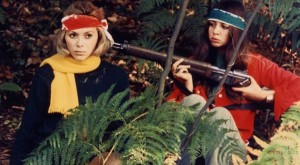STUDIO: Criterion | DIRECTOR: Jean-Luc Godard | CAST: Mireille Darc, Jean Yanne, Jean-Pierre Kalfon, Jean-Pierre Leaud, Juliet Berto, Laszlo Szabo, Paul Gegauff
RELEASE DATE: 11/13/12 | PRICE: DVD $29.95, Blu-ray $39.95
BONUSES: Excerpt from TV documentary on the film shoot, vintage interviews with the stars, new interviews with cinematographer Raoul Coutard and assistant director Claude Miller, video essay by critic Kent Jones
SPECS: NR | 104 min. | Foreign Language comedy drama | 1.66:1 widescreen | monaural | French with English subtitles
Reviews of Weekend, Jean-Luc Godard’s vibrant 1967 act of provocation, always zero in on two things — the fact that it was the last feature in an eight-year series of 15 films that made Godard arguably the most important filmmaker of the Sixties, and that it is “that French film with the long traffic jam.”
Both of the above items are true, but the “golden 15” argument is usually used to negate the superb work Godard has done in the last four decades (including the overwhelming Histoires du Cinema). And the traffic jam sequence in the film is justly famous for being both an all-purpose metaphor for modern society at its most immobilized and a well-executed comedy sequence — but it is hardly as long as it’s made out to be, since it lasts a grand total of seven minutes.
The traffic jam is just one incident (albeit a spectacularly staged one) in the nightmarish odyssey undertaken by Corinne and Roland Durand (Mireille Darc, Jean Yanne), a bourgeois couple who take a road trip to ensure that her rich and ailing father won’t change his will and disinherit them. That premise is the catalyst for the picture, but it is mostly forgotten as our opportunistic protagonists encounter a number of odd situations on the road.
The Alice in Wonderland aspect of their journey was surely intentional, but Carroll’s Alice was a sympathetic figure and the characters she encountered were, even when intent on menace, oddly endearing. The Durands are a shallow couple, and the characters they encounter are historical and literary figures who either lecture them or attempt to entertain them, until violence erupts.
The film’s rhythm changes decisively about an hour in. The feverish satire that characterizes the first 60 minutes gives over to a slower pace, which culminates in a darkly humorous finale in which the Durands are kidnapped by a band of backwoods radical hippies. Most viewers only remember incidents from the satirical first hour, but the allegorical nature of the Durands’ journey is the same throughout. The couple represents the worst aspects of consumer culture, and thus they have no patience for the artists they encounter (one particularly bizarre scene finds them setting fire to Emily Bronte!).
Critic Alain Bergala deemed Weekend “a rupture film” for Godard, one that transitioned him out of conventional narrative cinema —with the exception of Tout Va Bien (1972), he avoided clearcut linear storylines until Every Man For Himself in 1980. As he had done in his preceding film, La Chinoise (1967), Godard ponders in Weekend the possibility of a revolution in French (and Western) society while keeping in mind the biggest obstacle that any revolution faces, namely human nature.
Perhaps the greatest irony of this brutally satirical and cynical work is that Godard made it at the point when he was turning into an idealistic revolutionary convinced that Marxism held all the answers.
The Criterion release of the film, which now replaces the not very impressive and long out-of-print New Yorker version, contains a number of valuable supplements. The most info-packed of the lot are essays by Bergala and Gary Indiana, and a 1969 Godard interview by Jonathan Cott, found in the booklet included here.
The Bergala piece and a video essay by critic Kent Jones identify the literary and cinematic works cited in Weekend, while several interviews that appear on the disc explore the film’s shooting, and Godard’s characteristic crankiness on location. Darc and Yanne discuss the difficulties they faced on the shoot in 1967 TV footage, while Godard is seen in on-set footage, shot by Philippe Garrel.
Yielding the “juiciest” stories are new interviews with cinematographer Raoul Coutard and assistant director Claude Miller. Both agree that the film is a marvel of imagination and that Godard was in a bad mood throughout the shoot. Miller supplies the single best anecdote in the package when he remarks that the otherwise grumpy JLG really loved putting dents in the many cars seen in the film with a sledgehammer. He also enjoyed applying paint (as blood) on the actors, which makes perfect sense, given his painterly visual style and his not-very-secret disdain for his two stars.
|
Buy or Rent Weekend
|
|||
|---|---|---|---|
DVD |
 DVD | Blu-ray DVD | Blu-ray |
 DVD | Blu-ray DVD | Blu-ray |
|

Leave a Reply